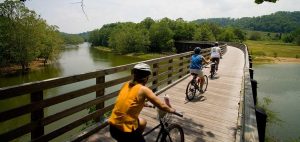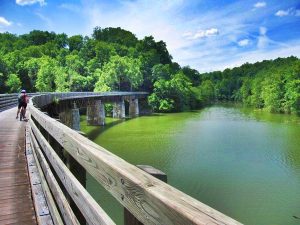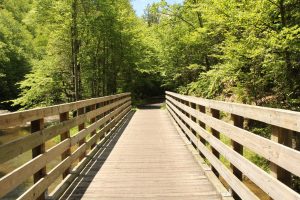|
|
The Virginia Creeper Trail: Partnerships Creating Public ValueBy Rick MorsePublished June 12, 2018
The rail right-of-way the Trail runs on dates back to the 1880s. After the last train used the rail line in the late 1970s, the idea for the trail began to take shape, with local advocates, spearheaded by Dr. French Moore, Jr., successfully arguing for maintaining the public right-of-way for the project. The U.S. Forest Service, National Park Service, and the two Towns took ownership of the different portions of right-of-way with the plan to use it for the recreational trail. Two million dollars in federal funding were also secured through the efforts of local Congressman Rick Boucher. The Trail was completed in 1984 and goes through both public and private land. A public-private (and intergovernmental) partnership that includes the U.S. Forest Service, the Towns of Damascus and Abingdon, and the Virginia Creeper Trail Club (i.e. local volunteers) maintains the trail. What you see today is a tremendous regional economic and cultural asset. You can read more about the Trail here. Like many partnerships, the success of the original partnership creates the conditions for more partnerships to form that add more value. For example, one stop along the Trail is the historic Green Cove train station which now functions as a U.S. Forest Service Visitor’s Center. The Virginia Creeper Trail Club provided $1,500 for materials and also secured a donation of lumber from a local lumber company. The Club also organized volunteers to perform the repairs and improve the station that sits near mile marker 30. The improvements benefit the Forest Service and add value to the Trail overall. There are many other cooperative efforts connected to the Trail such as festivals and other special events.
|
Published June 12, 2018 By Rick Morse
 This past weekend my wife and I took a short trip out to the mountains for our anniversary. Among our activities was peddling all 34 miles of the Virginia Creeper Trail, a beautiful gem stretching from White Top, through Damascus, to Abingdon, Virginia. In 2014, the Trail was inducted to the Rail-to-Trail Hall of Fame. This Virginia Creeper Trail has it all: beautiful views, a well-maintained trail, lots of history, amenities along the way, and stops in two delightful small towns. It is a huge economic asset to the region. More than a quarter million visitors ride the trail annually, giving steady business to bike outfitters, restaurants, hotels, and so on. The Trail is also a great example of how partnerships—intergovernmental and public-private—make assets like this possible.
This past weekend my wife and I took a short trip out to the mountains for our anniversary. Among our activities was peddling all 34 miles of the Virginia Creeper Trail, a beautiful gem stretching from White Top, through Damascus, to Abingdon, Virginia. In 2014, the Trail was inducted to the Rail-to-Trail Hall of Fame. This Virginia Creeper Trail has it all: beautiful views, a well-maintained trail, lots of history, amenities along the way, and stops in two delightful small towns. It is a huge economic asset to the region. More than a quarter million visitors ride the trail annually, giving steady business to bike outfitters, restaurants, hotels, and so on. The Trail is also a great example of how partnerships—intergovernmental and public-private—make assets like this possible.
The rail right-of-way the Trail runs on dates back to the 1880s. After the last train used the rail line in the late 1970s, the idea for the trail began to take shape, with local advocates, spearheaded by Dr. French Moore, Jr., successfully arguing for maintaining the public right-of-way for the project. The U.S. Forest Service, National Park Service, and the two Towns took ownership of the different portions of right-of-way with the plan to use it for the recreational trail. Two million dollars in federal funding were also secured through the efforts of local Congressman Rick Boucher. The Trail was completed in 1984 and goes through both public and private land.
A public-private (and intergovernmental) partnership that includes the U.S. Forest Service, the Towns of Damascus and Abingdon, and the Virginia Creeper Trail Club (i.e. local volunteers) maintains the trail. What you see today is a tremendous regional economic and cultural asset. You can read more about the Trail here.
Like many partnerships, the success of the original partnership creates the conditions for more partnerships to form that add more value. For example, one stop along the Trail is the historic Green Cove train station which now functions as a U.S. Forest Service Visitor’s Center. The Virginia Creeper Trail Club provided $1,500 for materials and also secured a donation of lumber from a local lumber company. The Club also organized volunteers to perform the repairs and improve the station that sits near mile marker 30. The improvements benefit the Forest Service and add value to the Trail overall. There are many other cooperative efforts connected to the Trail such as festivals and other special events.
 There are many other wonderful rails-to-trails projects like the Virginia Creeper Trail across the United States. They are all great examples of the benefits of not only eco-tourism, but of the kinds of partnerships that are often needed to create this kind of public value to communities and regions. Small communities in particular stand to benefit greatly from turning to their neighbors to develop their regional economies. In the case of the Virginia Creeper Trail, it has truly been a win-win. Together the communities (with federal and non-profit partners) have accomplished something far greater than they could have possibly achieved in isolation.
There are many other wonderful rails-to-trails projects like the Virginia Creeper Trail across the United States. They are all great examples of the benefits of not only eco-tourism, but of the kinds of partnerships that are often needed to create this kind of public value to communities and regions. Small communities in particular stand to benefit greatly from turning to their neighbors to develop their regional economies. In the case of the Virginia Creeper Trail, it has truly been a win-win. Together the communities (with federal and non-profit partners) have accomplished something far greater than they could have possibly achieved in isolation.
Author(s)
Tagged Under
This blog post is published and posted online by the School of Government to address issues of interest to government officials. This blog post is for educational and informational Copyright ©️ 2009 to present School of Government at the University of North Carolina. All rights reserved. use and may be used for those purposes without permission by providing acknowledgment of its source. Use of this blog post for commercial purposes is prohibited. To browse a complete catalog of School of Government publications, please visit the School’s website at www.sog.unc.edu or contact the Bookstore, School of Government, CB# 3330 Knapp-Sanders Building, UNC Chapel Hill, Chapel Hill, NC 27599-3330; e-mail sales@sog.unc.edu; telephone 919.966.4119; or fax 919.962.2707.

